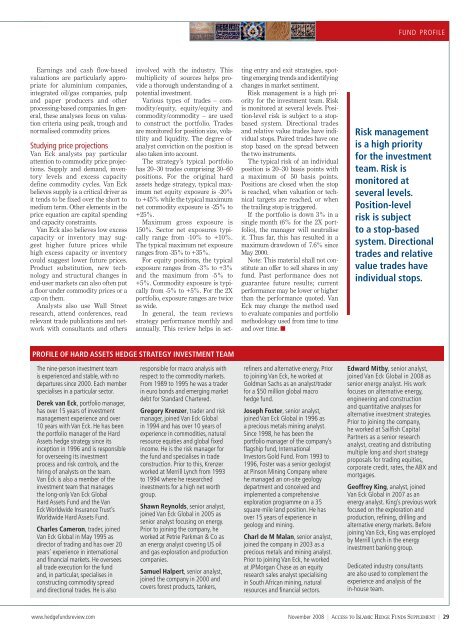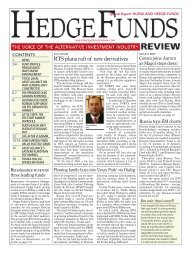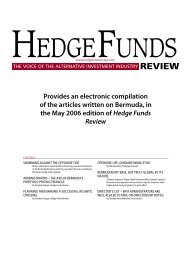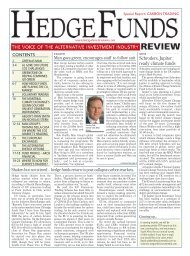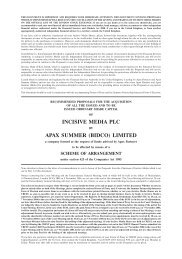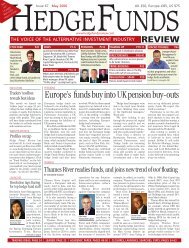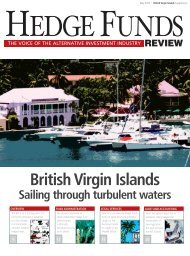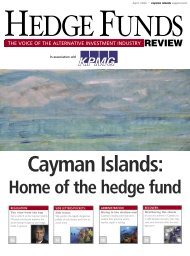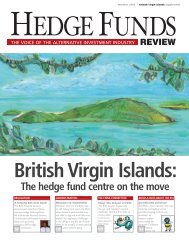Access to Islamic Hedge Funds - Incisive Media
Access to Islamic Hedge Funds - Incisive Media
Access to Islamic Hedge Funds - Incisive Media
Create successful ePaper yourself
Turn your PDF publications into a flip-book with our unique Google optimized e-Paper software.
fund profile<br />
Earnings and cash flow-based<br />
valuations are particularly appropriate<br />
for aluminium companies,<br />
integrated oil/gas companies, pulp<br />
and paper producers and other<br />
processing-based companies. In general,<br />
these analyses focus on valuation<br />
criteria using peak, trough and<br />
normalised commodity prices.<br />
Studying price projections<br />
Van Eck analysts pay particular<br />
attention <strong>to</strong> commodity price projections.<br />
Supply and demand, inven<strong>to</strong>ry<br />
levels and excess capacity<br />
define commodity cycles. Van Eck<br />
believes supply is a critical driver as<br />
it tends <strong>to</strong> be fixed over the short <strong>to</strong><br />
medium term. Other elements in the<br />
price equation are capital spending<br />
and capacity constraints.<br />
Van Eck also believes low excess<br />
capacity or inven<strong>to</strong>ry may suggest<br />
higher future prices while<br />
high excess capacity or inven<strong>to</strong>ry<br />
could suggest lower future prices.<br />
Product substitution, new technology<br />
and structural changes in<br />
end-user markets can also often put<br />
a floor under commodity prices or a<br />
cap on them.<br />
Analysts also use Wall Street<br />
research, attend conferences, read<br />
relevant trade publications and network<br />
with consultants and others<br />
involved with the industry. This<br />
multiplicity of sources helps provide<br />
a thorough understanding of a<br />
potential investment.<br />
Various types of trades – commodity/equity,<br />
equity/equity and<br />
commodity/commodity – are used<br />
<strong>to</strong> construct the portfolio. Trades<br />
are moni<strong>to</strong>red for position size, volatility<br />
and liquidity. The degree of<br />
analyst conviction on the position is<br />
also taken in<strong>to</strong> account.<br />
The strategy’s typical portfolio<br />
has 20–30 trades comprising 30–60<br />
positions. For the original hard<br />
assets hedge strategy, typical maximum<br />
net equity exposure is -20%<br />
<strong>to</strong> +45% while the typical maximum<br />
net commodity exposure is -25% <strong>to</strong><br />
+25%.<br />
Maximum gross exposure is<br />
150%. Sec<strong>to</strong>r net exposures typically<br />
range from -10% <strong>to</strong> +10%.<br />
The typical maximum net exposure<br />
ranges from -35% <strong>to</strong> +35%.<br />
For equity positions, the typical<br />
exposure ranges from -3% <strong>to</strong> +3%<br />
and the maximum from -5% <strong>to</strong><br />
+5%. Commodity exposure is typically<br />
from -5% <strong>to</strong> +5%. For the 2X<br />
portfolio, exposure ranges are twice<br />
as wide.<br />
In general, the team reviews<br />
strategy performance monthly and<br />
annually. This review helps in setting<br />
entry and exit strategies, spotting<br />
emerging trends and identifying<br />
changes in market sentiment.<br />
Risk management is a high priority<br />
for the investment team. Risk<br />
is moni<strong>to</strong>red at several levels. Position-level<br />
risk is subject <strong>to</strong> a s<strong>to</strong>pbased<br />
system. Directional trades<br />
and relative value trades have individual<br />
s<strong>to</strong>ps. Paired trades have one<br />
s<strong>to</strong>p based on the spread between<br />
the two instruments.<br />
The typical risk of an individual<br />
position is 20–30 basis points with<br />
a maximum of 50 basis points.<br />
Positions are closed when the s<strong>to</strong>p<br />
is reached, when valuation or technical<br />
targets are reached, or when<br />
the trailing s<strong>to</strong>p is triggered.<br />
If the portfolio is down 3% in a<br />
single month (6% for the 2X portfolio),<br />
the manager will neutralise<br />
it. Thus far, this has resulted in a<br />
maximum drawdown of 7.6% since<br />
May 2000.<br />
Note: This material shall not constitute<br />
an offer <strong>to</strong> sell shares in any<br />
fund. Past performance does not<br />
guarantee future results; current<br />
performance may be lower or higher<br />
than the performance quoted. Van<br />
Eck may change the method used<br />
<strong>to</strong> evaluate companies and portfolio<br />
methodology used from time <strong>to</strong> time<br />
and over time. n<br />
Risk management<br />
is a high priority<br />
for the investment<br />
team. Risk is<br />
moni<strong>to</strong>red at<br />
several levels.<br />
Position-level<br />
risk is subject<br />
<strong>to</strong> a s<strong>to</strong>p-based<br />
system. Directional<br />
trades and relative<br />
value trades have<br />
individual s<strong>to</strong>ps.<br />
profile of hard assets hedge strategy investment team<br />
The nine-person investment team<br />
is experienced and stable, with no<br />
departures since 2000. Each member<br />
specialises in a particular sec<strong>to</strong>r.<br />
Derek van Eck, portfolio manager,<br />
has over 15 years of investment<br />
management experience and over<br />
10 years with Van Eck. He has been<br />
the portfolio manager of the Hard<br />
Assets hedge strategy since its<br />
inception in 1996 and is responsible<br />
for overseeing its investment<br />
process and risk controls, and the<br />
hiring of analysts on the team.<br />
Van Eck is also a member of the<br />
investment team that manages<br />
the long-only Van Eck Global<br />
Hard Assets Fund and the Van<br />
Eck Worldwide Insurance Trust’s<br />
Worldwide Hard Assets Fund.<br />
Charles Cameron, trader, joined<br />
Van Eck Global in May 1995 as<br />
direc<strong>to</strong>r of trading and has over 20<br />
years’ experience in international<br />
and financial markets. He oversees<br />
all trade execution for the fund<br />
and, in particular, specialises in<br />
constructing commodity spread<br />
and directional trades. He is also<br />
responsible for macro analysis with<br />
respect <strong>to</strong> the commodity markets.<br />
From 1989 <strong>to</strong> 1995 he was a trader<br />
in euro bonds and emerging market<br />
debt for Standard Chartered.<br />
Gregory Krenzer, trader and risk<br />
manager, joined Van Eck Global<br />
in 1994 and has over 10 years of<br />
experience in commodities, natural<br />
resource equities and global fixed<br />
income. He is the risk manager for<br />
the fund and specialises in trade<br />
construction. Prior <strong>to</strong> this, Krenzer<br />
worked at Merrill Lynch from 1993<br />
<strong>to</strong> 1994 where he researched<br />
investments for a high net worth<br />
group.<br />
Shawn Reynolds, senior analyst,<br />
joined Van Eck Global in 2005 as<br />
senior analyst focusing on energy.<br />
Prior <strong>to</strong> joining the company, he<br />
worked at Petrie Parkman & Co as<br />
an energy analyst covering US oil<br />
and gas exploration and production<br />
companies.<br />
Samuel Halpert, senior analyst,<br />
joined the company in 2000 and<br />
covers forest products, tankers,<br />
refiners and alternative energy. Prior<br />
<strong>to</strong> joining Van Eck, he worked at<br />
Goldman Sachs as an analyst/trader<br />
for a $50 million global macro<br />
hedge fund.<br />
Joseph Foster, senior analyst,<br />
joined Van Eck Global in 1996 as<br />
a precious metals mining analyst.<br />
Since 1998, he has been the<br />
portfolio manager of the company’s<br />
flagship fund, International<br />
Inves<strong>to</strong>rs Gold Fund. From 1993 <strong>to</strong><br />
1996, Foster was a senior geologist<br />
at Pinson Mining Company where<br />
he managed an on-site geology<br />
department and conceived and<br />
implemented a comprehensive<br />
exploration programme on a 35<br />
square-mile land position. He has<br />
over 15 years of experience in<br />
geology and mining.<br />
Charl de M Malan, senior analyst,<br />
joined the company in 2003 as a<br />
precious metals and mining analyst.<br />
Prior <strong>to</strong> joining Van Eck, he worked<br />
at JPMorgan Chase as an equity<br />
research sales analyst specialising<br />
in South African mining, natural<br />
resources and financial sec<strong>to</strong>rs.<br />
Edward Mitby, senior analyst,<br />
joined Van Eck Global in 2008 as<br />
senior energy analyst. His work<br />
focuses on alternative energy,<br />
engineering and construction<br />
and quantitative analyses for<br />
alternative investment strategies.<br />
Prior <strong>to</strong> joining the company,<br />
he worked at Sailfish Capital<br />
Partners as a senior research<br />
analyst, creating and distributing<br />
multiple long and short strategy<br />
proposals for trading equities,<br />
corporate credit, rates, the ABX and<br />
mortgages.<br />
Geoffrey King, analyst, joined<br />
Van Eck Global in 2007 as an<br />
energy analyst. King’s previous work<br />
focused on the exploration and<br />
production, refining, drilling and<br />
alternative energy markets. Before<br />
joining Van Eck, King was employed<br />
by Merrill Lynch in the energy<br />
investment banking group.<br />
Dedicated industry consultants<br />
are also used <strong>to</strong> complement the<br />
experience and analysis of the<br />
in-house team.<br />
www.hedgefundsreview.com November 2008 | <strong>Access</strong> <strong>to</strong> <strong>Islamic</strong> <strong>Hedge</strong> <strong>Funds</strong> Supplement | 29


